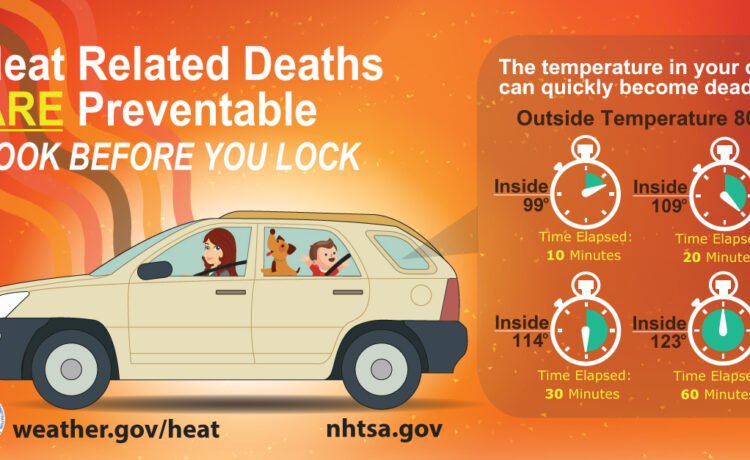RICHMOND, Va. (WRIC) — A child can die from heatstroke within minutes of being left in a hot car. With a heatwave on the way, here’s what you can do to avoid the same tragedy that’s already impacted dozens of families across Virginia.
From 1998 through the end of 2024, a total of 32 children died of heatstroke due to being left in a hot car in Virginia, according to No Heat Stroke. Nationwide, the death toll is over 1,000.
Why are hot cars so deadly for kids?
Heatstroke occurs when body temperature reaches 104 degrees, and death can occur starting at 107 degrees — and children’s body temperatures rise three to five times faster than an adult’s on average, making them especially susceptible, according to the National Highway Traffic Safety Administration (NHTSA).
Even when outside temperatures are only at 80 degrees, the temperature inside your car can reach 99 degrees within just 10 minutes, per the National Weather Service (NWS). It can hit 109 degrees in only 20 minutes.
Due to all of these factors, children can die inside a hot car in mere minutes — and, while these preventable deaths can happen year-round, extreme heat certainly does not help the situation.

The Richmond region will experience a heatwave starting on Sunday, June 22. Throughout the week, temperatures are expected to hit 100 degrees Fahrenheit with a heat index of nearly 115, according to StormTracker8 Chief Meteorologist Matt DiNardo.
In the face of such extreme heat, it’s important to take precautions to protect your children from these unnecessary deaths.
Just knowing the risks of a hot car isn’t enough
Even if you are someone who would never intentionally leave a child in a hot car, accidents happen — in fact, only just under 22% of pediatric hot car deaths involve children who were knowingly left, per No Heat Stroke.
In 23.8% of cases, children accessed an unlocked car, became trapped inside and died.
However, the majority of cases (52.6%) involved a caregiver forgetting the child was there — with 45% of those cases involving a child not being dropped off at childcare.


This means the best practice for those who are ever responsible for children is to be aware of your backseat even when you are convinced you are supposed to be alone.
So what can I do to protect my family?
The NHTSA offers the following tips for preventing pediatric hot car deaths:
- Don’t knowingly leave your child. Never leave a child unattended in a vehicle for any amount of time — even if you put the windows down or park in the shade. Those “precautions” do not help.
- Help yourself avoid making a tragic mistake. Develop a habit of always checking your entire vehicle, particularly the backseat, before getting out and leaving.
- Reinforce that habit with something tangible. Put your purse, briefcase or something else you’ll need for your day in the backseat so you’ll be forced to “look before you lock.” You could also put a note somewhere visible or a stuffed animal in your passenger seat.
- Set up a system with your childcare. Ask your childcare provider to call you if your child is ever supposed to be there but isn’t dropped off.
- Never leave your car unlocked, even at home. Prevent your child — or any child, for that matter — from accidentally accessing your car by making sure it’s always locked.
- Store your keys in a safe place. Keep your car keys out of the reach of little hands. Additionally, consider teaching your children about the dangers of being alone in a car and how it is not a play area.
If you ever find a child trapped in a locked car, the NHTSA encourages you to call 911 immediately.
Notably, Virginia does not have a law in place that dictates specific punishments for leaving a child in a vehicle, and 21 other states do, per No Heat Stroke. However, it does have a “Good Samaritan” law providing protections for bystanders who act to free a child left in a hot car.
For the most up-to-date weather alerts, click here or visit our StormTracker8 weather page.








